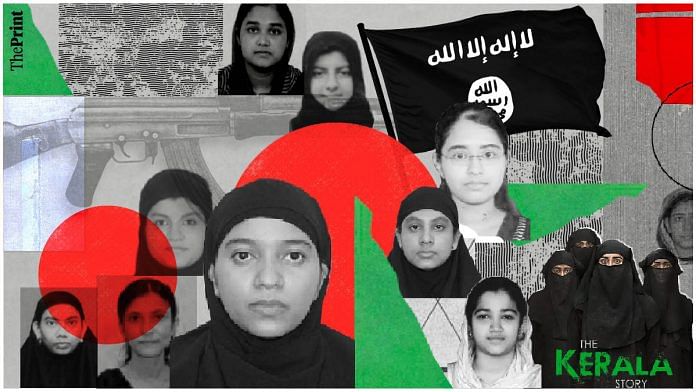New Delhi: Hyderabad-born Zeba Farheen’s trans-national nightmare is thought to have begun when she was a teenager studying at a school in Qatar.
At some point in 2013, she apparently became friends with Heba, a classmate from Kerala, and through her, met a Yemeni nurse who worked at a hospital in Doha. On 24 October that year, Zeba, then around 15 years old, is believed to have left her house in secret to take a flight to Istanbul with the nurse.
Zeba and the nurse were later joined by two Turkish women, and they embarked on a six-to-seven-hour drive to a location that was “probably in Syria”, according to government records. Zeba claimed she was kept captive in a house there for more than 20 days.
Then, in early December 2014, Zeba managed to escape and was able to contact her parents. The Indian Embassy in Istanbul arranged for her return to Doha, Qatar, before sending her back to India.
Zeba’s dramatic story is tucked away in a government intelligence dossier on 133 Indians who travelled, or tried to do so, to the Islamic State (IS) “conflict theatre” in the past decade or so.
The list, accessed by ThePrint, contains the names and details of 28 women in all, of whom 22 were from Kerala, with the rest coming from Hyderabad, Karnataka, and Maharashtra.
These names include those of the four women who purportedly served as inspiration for the main characters in the film The Kerala Story, which has been generating controversy and minting crores at the box office ever since its release this month.
#TheKeralaStory is not slowing down soon… Hits double digits on [second] Mon, HIGHER than [first] Mon – ₹ 10.03 cr… All set to cross ₹ 150 cr today [second Tue]… [Week 2] Fri 12.35 cr, Sat 19.50 cr, Sun 23.75 cr, Mon 10.30 cr. Total: ₹ 147.04 cr. #India biz. #Boxoffice pic.twitter.com/yJ7V8dpQuV
— taran adarsh (@taran_adarsh) May 16, 2023
While a debate rages over whether the film is poisonous propaganda — a stand also taken by Kerala Chief Minister Pinarayi Vijayan — or a cautionary tale, ThePrint looks at some of the real women who allegedly left India to join the IS.
Although details are sparse in the government list, it paints a varied profile of these alleged IS migrants.
A small handful converted to Islam from Christianity or Hinduism, some were mothers, some were widowed, some were killed in conflicts, and others are still detained in countries such as Syria and Afghanistan. Most followed their husbands to IS conflict zones and never made it out, but there are rare exceptions — like Zeba.
Court documents, news coverage, and rare media interviews with some of these women add more detail to the picture. One was studying to be a dentist, one held an engineering degree, several spoke fluent, articulate English. There are cases in India against some, and others have no crime on their records.
Chances that any will be brought back to India are low — whether for trial if they are wanted by investigative agencies, or for reintegration into their families and communities.
A senior intelligence officer had told ThePrint earlier this year that the government’s view is that there is no “realistic prospect” of getting convictions and that the danger of potentially “returning trained, battle-hardened jihadists into the community is just too high”.
Also Read: BJP can’t win over Kerala by giving it a bad image. Best to leave the state alone
‘Inspirations’ for The Kerala Story, Kasaragod factor
The Kerala Story, with much melodrama, tells the stories of four women. The main character, a Hindu woman called Shalini Unnikrishnan (played by Adah Sharma), is shown to have a horrifying experience after she is radicalised, including being forced to serve as a sex slave to terrorists in Syria and ending up in an Afghan jail.
The film also shows the stories of two other women who are brainwashed to varying extents — Gitanjali Menon (played by Siddhi Idnani), who converts to Islam, and Nimah Mathew (played by Yogita Bihani), who does not convert.
A fourth character, Asifa (played by Sonia Balani) repeatedly emphasises the fear of Allah and asserts that girls who wear hijabs are never subjected to rape.
One scene stands out, in which Nimah approaches the police and asks: “Do you know, sir, that there are some villages in Kasaragod where Sharia is prevalent? Whenever there is a bomb blast anywhere in the world, be it in Sri Lanka, Singapore or Afghanistan, there is always a Kerala connection. Why does this happen, sir?”
The real women who purportedly inspired these characterisations, notably, were among a wave of 21 people who reportedly moved to Afghanistan to join IS in the summer of 2016. Most were said to have been radicalised in Kasaragod.
Nimisha alias Fathima Isa — said to be the model for Shalini Unnikrishnan — was a student of dentistry at Century College in Kasaragod district when she reportedly converted to Islam.
Sonia Sebastian, alias Ayisha, and Merrin Jacob, alias Mariyam, were Christians before marrying Muslim men and converting to Islam. Another woman, Reffeala from Kasargod, was married to a doctor called Ijas.
The four had moved to Afghanistan from Kerala in 2016, following their husbands who had reportedly been radicalised and sought to become Islamic State fighters.
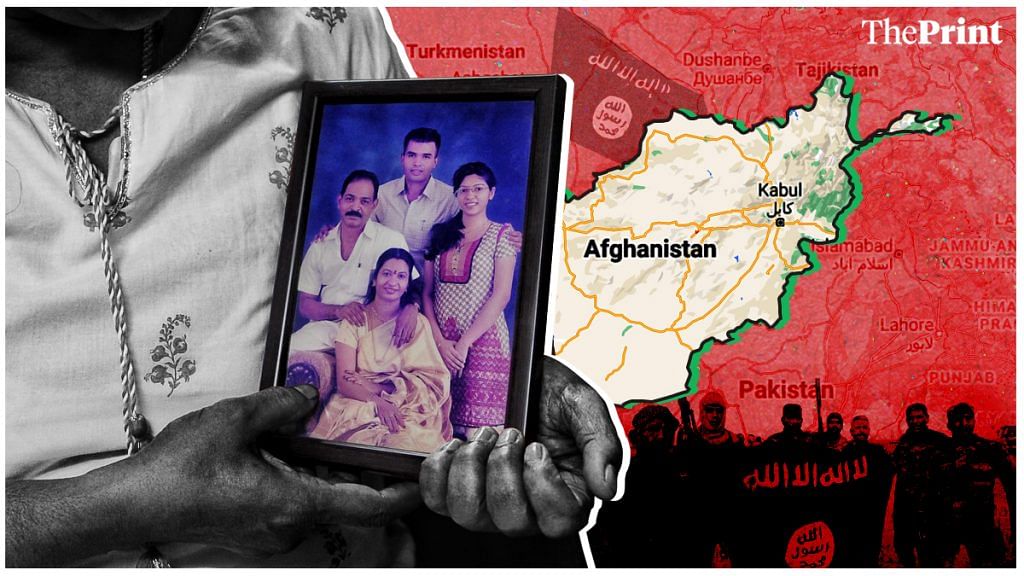
A man named Abdul Rashid Abdulla — Sonia Sebastian’s husband — was the alleged “main conspirator” behind getting young people from Kasaragod and Palakkad to join IS, according to a 2017 National Investigation Agency (NIA) press release. He was reportedly killed during an air strike in Afghanistan in 2019.
In 2018, Yasmin Mohammed Zahid — another wife of Abdul Rashid, according to a News Minute report — was sentenced to seven years in prison by a special NIA court for allegedly recruiting 15 people to join IS. She was reportedly apprehended at Delhi international airport in July 2016 while attempting to leave for Kabul with her son.
Meanwhile, Nimisha, Sonia Sebastian, Merrin Jacob, and Reffeala emerged back into public view in 2019. This was after they became “IS windows” and surrendered to Afghan forces. Some among them were even interviewed while in an Afghan detention centre for a 2020 documentary called Khorasan Files: The Journey Of Indian ‘Islamic State’ Widows.
In 2021, again, there was renewed attention on the women amid speculation that the Taliban takeover of Afghanistan could result in their release from prison and return to India.
Sonia’s father, V.J. Sebastian Francis, moved the Supreme Court in 2021 asking that she be extradited to India with her daughter. Nimisha’s mother, Bindu Sampath, has also been making entreaties for her return. In a 2017 petition to the Supreme Court, Sampath had claimed that her daughter had been “brainwashed, radicalised and forced to join jihad of ISIS in Afghanistan”.
Currently, Nimisha is listed as “absconding” in the NIA’s “ISIS Palakkad case”. She is believed to have been released from prison after the Taliban takeover in 2021, and it is not known where she is currently.
Her mother had told ThePrint then: “I don’t even know if she is alive or dead. If she is brought back, I know she might be imprisoned, but at least she will be tried as per Indian law.”
Also Read: First Lady of ISIS, now ‘the other woman’ of US Rep, Tania Joya got lucky unlike many others
How many converts on the list?
Other than Nimisha, Sonia Sebastian, and Merrin Jacob, only one other woman was clearly a convert to Islam from another religion — Ritika Jaya Shetty, alias Maryam. The government list describes her as being “born into a Hindu family”.
Originally from Mumbai, Shetty was living in Qatar when she met and married an Indian-origin man called Mohammad Kamil Sultan, apparently a “champion runner”.
She is believed to have left for Syria or Iraq with her husband in 2014. Her “whereabouts are not known”, according to the government document, and neither are her husband’s.
Caliphate dreams, hijrah, death
In an interview that appeared in the documentary Khorasan Files, released by strategic affairs website StratNews Global, Sonia Sebastian, the wife of alleged IS recruiter Abdul Rashid, spoke articulately in English about how her “expectations” of living an Islamic life were not borne out by reality — the people weren’t as religious as she would have liked, she said.
Sebastian, described in reports as holding an engineering degree, also expressed her desire to return to India and live with her husband’s family.
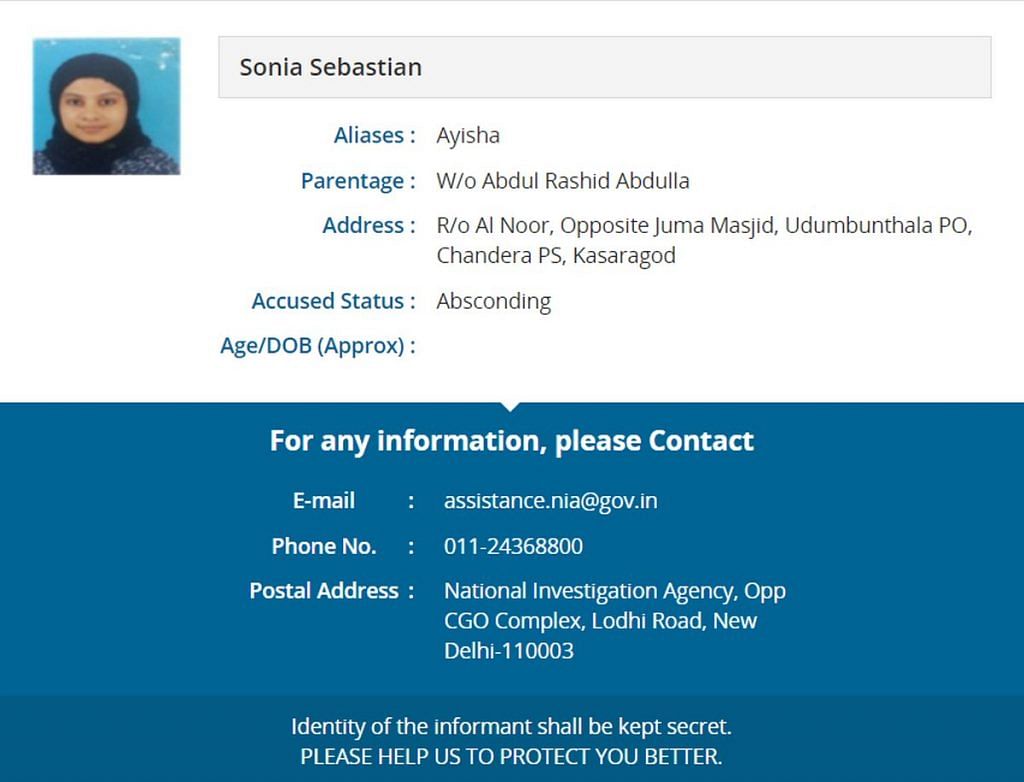
In a separate 2020 interview with the UAE-based media outlet The National News, Merrin Jacob, who was once Catholic and an IBM employee, said all she ever wanted was to live in a place with Sharia law. She said she was “happy” and lived a “peaceful life” in Afghanistan until the family had to go on the run. Her first and second husbands were both killed.
In the government intelligence document cited earlier, Sonia and Merrin are both listed as “detained in Afghanistan”. Sonia is among the “absconding” accused in the “ISIS Kasargod case” and Merrin in the “ISIS Palakkad case”.
Indeed, whatever dreams that individuals like Sebastian or Jacob may have harboured about living the IS life might have gone to smoke as the caliphate crumbled under sustained attacks from Iraqi, Syrian, and multinational forces.
Some women died, some are stuck in detention centres, and others have seemingly disappeared.
One instance is that of Safna Mulayampilly Kuttathil from Ernakulam, who went with her husband Shefeeq to perform “hijrah” from the UAE in December 2018.
Traditionally, the term hijrah refers to the migration of the Prophet Muhammad from Mecca to Medina in 622 CE, symbolising the beginning of the Islamic calendar. However, IS co-opted the term while exhorting Muslims to make “hijrah” to regions under its control.
In 2014, Abu Bakr al-Baghdadi, the now-deceased leader of the Islamic State, extended a fervent invitation to Muslims worldwide, telling them it was their duty to migrate and help create the caliphate.
In one audio message, he is reported to have said: “Go ahead Muslims. Yes, this is your kingdom. Go ahead because Syria is not just for Syrians and Iraq is not just for Iraqis.”
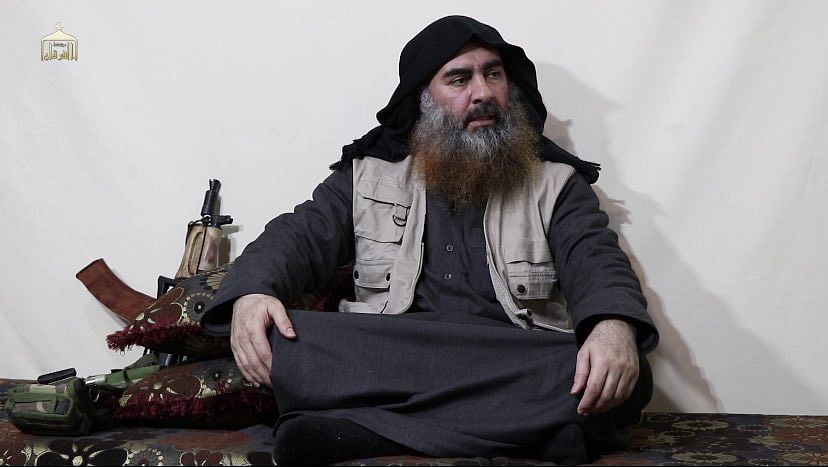
In January 2019, Safna and her husband had “informed” — the government document does not say who they informed — that they had performed the said “hijrah” to a “wilayat of the Khilafat (caliphate) that was formed in 2014”.
This was a reference to the Islamic State Khorasan Province (ISKP), which emerged in 2014 as an affiliate of the IS, and aimed to establish a ‘caliphate’ in the region of Khorasan, historically encompassing parts of Afghanistan, Pakistan, Iran, and Central Asia. The ISKP has been involved in various acts of violence, including suicide bombings.
Not long after their arrival, both husband and wife were killed in Khorasan.
Ramshimol of Thirathal in Kerala also “performed hijrah to ISKP” (it is not clear when in the government document), and is believed to currently be in Syria. However, her husband was detained when attempting to do his “hijrah” to Syria from the UAE.
Another couple doing “hijrah” — Huda Raheem of Kozhikode and her husband Rishal — left for Istanbul via Dubai in 2015, embarking from there to Syria. He was reportedly killed, but she is believed to still be somewhere in Syria or Iraq.
Expat lives to detention camps and worse
In September 2013, Arjumand Banu from Hyderabad and her husband Muhammad Ikramuddin flew to Riyadh along with their two children. The young family eventually wound their way to Syria and never returned.
“For families like mine, the situation is extremely painful,” Ikramuddin’s father had told ThePrint earlier this year.
Like many other Indian men who joined IS, Ikramuddin worked outside the country and had a good job in Saudi Arabia.
He was killed in combat and Arjumand Banu and the children are believed to be lodged in al-Hawl (or al-Hol), a notorious camp in northeast Syria that’s sometimes called a “mini-state” of IS.
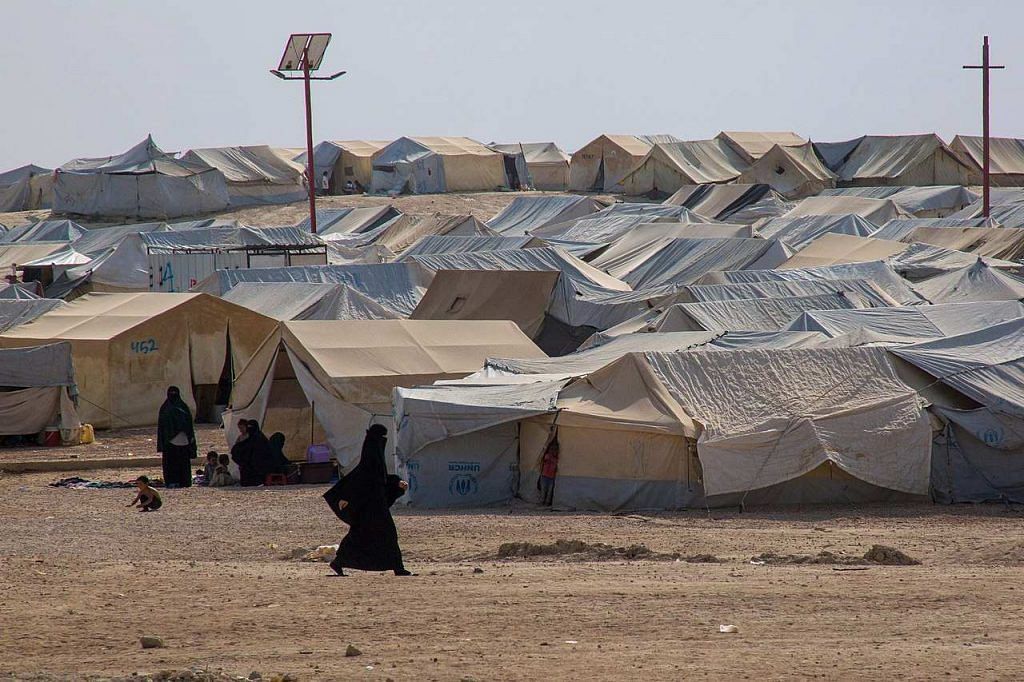
According to a May 2022 analysis by the United States Institute of Peace, a Washington-based think tank, the camp houses over 56,000 people, many of them the wives and children of IS fighters. The analysis notes that that some of the camp’s women “have played the role of enforcers” in perpetuating extremist ideology and strictures “by meting out harsh punishment, including death, to those women who do not obey”.
Also at al-Hawl, according to sources in the security establishment, is Risvana Kalathil from Kannur, who is suspected to have joined IS along with her husband Zuhail after locking up their Dubai home in early 2017. She and the couple’s three children— Rayaan, Rehaan, and Bint Zoha — are at the camp, while Zuhail’s whereabouts are not known.
Other detainees in Syria include Amani Fatima from Mumbai and her son. She joined the “conflict theatre” in Syria along with her husband Abu Hufaiza Naseem Khan, a mechanical engineer who worked in the Delhi and Mumbai metro rail projects before moving to Bahrain for work. He has been killed in the conflict, according to the document.
Fabna Nalakath, also known as Febina, a resident of Malappuram in Kerala, ventured into Syria or Iraq alongside her husband Mohammed Mansoor Perunkalleeri and their daughter Hanya Perunkalleeri, born in 2013. It is believed that they are currently located in one of the camps within the region.
A tourist visa to Istanbul was the launching point to Syria for Soufia Mohammad Muqeet, who comes from the Deori Bazar area of Aurangabad in Maharashtra. She and her husband, a Jeddah-based engineer, crossed over to Syria at some point in 2015. It is not known where they are at present.
Turkey was also a part of the itinerary of Shabnam Iqbal from Ernakulam and her husband Hashir, who worked at an oil company in Qatar.
Going against the wishes of their family members, they purportedly moved to Turkey to do “charity work”, but landed up in Syria with their newborn daughter at some point in 2014. They are believed to be “possibly” in the region still.
Then there is Shazia Ahmed Tabassum of Bengaluru, who migrated with her husband Thayyib Shaik Meera — a permanent resident of Canada — and three children to join IS forces in Syria around 2015. Their whereabouts are unknown.
The outcome is known to be worse for Fousiya from Kannur, who went from Dubai to Syria or Iraq with her husband and three children in 2015. She lost her life as did her husband Muhammad Sameer, a “sub-divisional convenor” of the now-banned Islamist outfit Popular Front of India. Their three children, including a daughter who was only 11 when they went to Syria, are dead too.
(Edited by Asavari Singh)
Also Read: Engineer from Ranchi built drones for IS, revolutionised terror tech. Now he’s in Turkish jail


